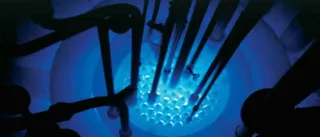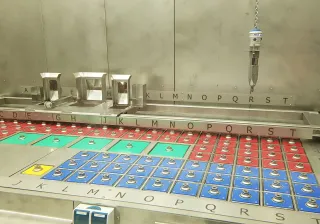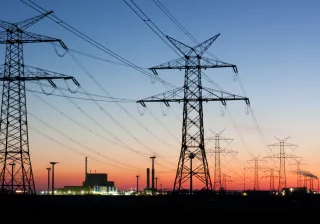Decommissioning of FiR 1 nuclear reactor

The FiR 1 research reactor, which has served as a key nuclear energy and educational research facility for 50 years, was shut down permanently on 30 June 2015. The Council of State granted VTT a decommissioning licence in June 2021.

The FiR 1 research reactor that Finland purchased from the United States was started up ceremonially in Otaniemi in 1962. Originally intended for use in research and education, this water-cooled, pool-type TRIGA reactor specifically designed for university environments also served in isotope production and radiation therapy. The reactor's fission power was at the low level of 250 kW and it was limited to daytime operation, with no use being made of its heat energy.
Responsibility for the reactor was transferred to VTT from Helsinki University of Technology by a Government decision in 1971.
In the early days, the reactor was mainly used for neutron and reactor physics research and national education. At a later stage, intensive use was made of its radiation for chemical element analyses, including soil and lunar soil samples. In the 1990s, the reactor was complemented with radiotherapy equipment based on the reactor's neutron radiation, modified for patient care using moderator material technology developed by VTT. Radiotherapy ended in January 2012, when the company organising it went bankrupt – only minor use has been made of the reactor since then.
Safety as the focus
The Council of State granted to VTT the decommissioning licence in June 2021. Prior to submitting the licence application, VTT completed an environmental impact assessment on the decommissioning and dismantling of the reactor. As part of the review of the decommissioning licence application, the Radiation and Nuclear Safety Authority of Finland (STUK) gave their safety assessment on decommissioning. VTT will carry out the decommissioning and nuclear waste management in collaboration with Fortum.
Because the reactor is a small, operationally safe nuclear facility designed for educational use, the amounts of spent fuel, decommissioning waste and the associated radioactivity will be relatively minor. Safety will be an absolute priority during the planning and execution of the plant's decommissioning. All measures related to the decommissioning will be carried out under the supervision of STUK.
Concerning waste management, spent nuclear fuel requires one solution and the low- and intermediate level dismantling waste its own solution. The reactor at the U.S. Geological Survey (USGS), located in Denver, received the used fuel from FiR 1 in January 2021. Arranging spent fuel management abroad is an exception permitted by the Finnish Nuclear Energy Act. Before sending the fuel, Finland received a report of the US authorities on their commitment to the management of the fuel batch. When the USGS ceases to use its reactor, it will deliver the spent fuel to Idaho National Laboratory, where several countries have previously sent similar batches of nuclear fuel from research reactors.
Fortum manages the interim storage and later final disposal of the dismantling waste in a Finnish final disposal facility.
No nuclear reactors have been decommissioned in Finland before. By contrast, several reactors of a corresponding type have been decommissioned in countries such as Denmark and Germany and the lessons learned will be applied when the Otaniemi reactor is decommissioned. In turn, experiences from decommissioning the Otaniemi reactor can be applied when planning the decommissioning of Finnish nuclear power plants.
Business ecosystem
Starting from late 2019, VTT is coordinating a business ecosystem on nuclear decommissioning. The project is co-funded by Business Finland.
The ecosystem has several industrial partners and is conducting research and development in several interlinked projects in the companies and at VTT. The companies operate together to identify development opportunities and challenges, and launch development projects. One of these challenges has been the recognition of companies outside the industry as supplier of products and services for nuclear decommissioning projects.
FIR 1 timeline
- 1962: Helsinki University of Technology commissions a Triga Mark II research reactor, which is named FiR 1.
- 1967: The maximum thermal power is raised to 250 kW following tests and modifications.
- 1971: The research reactor operational responsibility is moved from Helsinki University of Technology to VTT Technical Research Centre of Finland.
- 1999: The reactor is used for the first time to provide cancer treatment in collaboration with the Hospital District of Helsinki and Uusimaa.
- 2012: The cancer treatment provider goes out of business.
- 2015: The reactor is run for the last time on 30 June 2015.
- 2020: The transportation of the spent nuclear fuel to the U.S. Geological Survey (USGS)
- 2021: Decommissioning licence
- 2021-22: The preparation of the demolition work.
- 2023: Dismantling and interim storage of the dismantling waste starts.
- 2024: The empty reactor building is decontaminated and released.
Decommissioning
The reactor structures (concrete radiation shielding, aluminium pool and core structures, cooling circuits and instrumentation) will be dismantled in stages after the spent nuclear fuel has been removed from the reactor.
This will result in a few dozen cubic metres of low and intermediate-level radioactive concrete, steel, aluminium, graphite and Fluental moderator material used for radiotherapy. These materials will be non-combustible. Part of the concrete in the reactor has not become radioactive and, after precautionary measurements, can be recycled as normal construction waste. If possible, some reactor components and materials will be re-used in other research reactors, which will reduce the amount of waste.
A small amount of low-level radioactive waste, such as overalls and cleaning resins, will also result from the operation and decommissioning of the reactor. Account will be taken of fire safety during the packaging and storage of these materials.
Once the reactor has been dismantled, the surfaces of the reactor building will be decontaminated and careful radiation measurements will be taken to ensure its safety for other purposes.
Read our whitepaper about new solutions for nuclear decommissioning
Our whitepaper Nuclear decommissioning expertise in Finland showcases how companies can reduce costs and improve the safety of nuclear decommissioning projects.
Nuclear waste
Management of nuclear waste from the research reactor includes the disposal of spent nuclear fuel and the safe handling and final disposal of decommissioning waste.
Spent nuclear fuel from the research reactor can be returned to its country of origin, the United States, in accordance with the Nuclear Energy Act. At the end of operation, the United States will take care of the fuel.
Final disposal of decommissioning waste from the reactor will be performed in a final disposal facility in Finnish bedrock.
Licencing and monitoring
All decommissioning tasks are carried out under the control of the Radiation and Nuclear Safety Authority of Finland (STUK). Prior to applying the licence for decommissioning, VTT performed an environmental impact assessment concerning the decommissioning and dismantling of the reactor.
In the licence application, VTT has described plans for the safe disposal of the related nuclear waste and technical and organisational measures for guaranteeing safety and the minimisation of any environmental impact associated with the dismantling of the reactor. STUK has reviewed the technical plans and reports submitted by VTT and given to the Finnish Government the safety assessment on the decommissioning of the reactor.
Transport and storage
Low and intermediate-level decommissioning waste will be transported to monitored storage by road. A safety analysis has been performed for this purpose, on the basis of which the related packages will be selected on the basis that they provide reliable radiation protection in both normal circumstances and accidents.
Proper packaging of the waste and, if necessary, additional radiation protection will be used to ensure no effects from radiation outside the decommissioning waste storage facility. Unauthorised access to the storage facilities will be prevented. The storage facility will be protected from external humidity and equipped with air conditioning subject to radiation monitoring.
Links and more information
- dECOmm project 2019-23 Final report
- Project’s publications in VTT’s research information portal
- VTT received decommissioning licence for research reactor (VTT 17.6.2021)
- Used fuel from VTT’s research reactor set for further use in USA (VTT 10.2.2021)
- VTT and Fortum join forces to decommission a research reactor and laboratory (VTT 7.4.2020)
- Licensing for decommissioning (Ministry of Economic Affairs and Employment)
- Finland’s old nuclear research reactor to be decommissioned – New Centre for Nuclear Safety under construction (VTT Impulse 2/2015)
- The glow of Finland’s first reactor fades (Nuclear Engineering International, 22.12.2015)
- Environmental impact assessment (in Finnish) (Ministry of Economic Affairs and Employment)
- Video:The story of Finland's first nuclear reactor (narration in Finnish)
Questions and answers
Will the dismantling of the reactor be safe for people and the environment?
- Responsibility forms the basis of VTT’s operational planning. In collaboration with Pöyry, an environmental impact assessment (EIA) has been performed for the decommissioning, and the Ministry of Economic Affairs and Employment has issued a favourable statement on the EIA. Human and environmental safety will be the top priorities during the dismantling of the reactor. The appropriate handling of the components (e.g. dust-free dismantling techniques, the extraction of all liquids) and sealed ventilation inside the reactor building will prevent waste from entering the environment. The related emission and environmental radiation monitoring will be performed in accordance with the regulations issued by the Radiation and Nuclear Safety Authority of Finland (STUK). In addition, foreign expertise on the dismantling of nuclear reactors, such as that of Studsvik (Sweden) and Risø (Denmark), will be consulted.
Will dismantling the reactor create a risk?
- The reactor is a small facility, which is safe to operate and designed for educational use.
- The amount of spent nuclear fuel in this small reactor amounts to 'one wheelbarrow load' with one-hundred-thousandth of the radioactivity of a nuclear power plant. In addition, the number of radioactive elements is a fraction – just a few dozen cubic metres – of the amount of such material in a nuclear power plant.
- Occupational safety and the radiation protection of workers will be effectively managed, in accordance with regulatory requirements.
How will the dismantling work be handled safely enough to ensure that no accidents occur?
- VTT will require an absolute commitment to act responsibly with regard to nuclear and general occupational health and safety from all contractors participating in the dismantling work. All major work will be carefully planned and the associated risks will be mapped out in advance. Before each and every phase of the work begins, the related plans must be approved by each person responsible for the various safety areas involved.
How will spent fuel be handled during the dismantling process?
- All spent fuel has been transported away from the site before dismantling begins.
What is the quantity of decay heat in the fuel and to what can it be compared?
- The decay heat of one spent fuel rod used in an FiR 1 research reactor is less than 1 watt, which does not raise the fuel temperature much above the ambient temperature. This means that a dry container was suitable for transporting the spent research reactor fuel. This is very different in the case of nuclear power plant reactors: Spent fuel from such reactors generates several kilowatts of decay heat (about the same as an electric sauna stove) per bundle and requires constant cooling to prevent fuel damage.
How will the safety and cleanliness of the work site be sufficiently ensured to avoid any harm to people or the environment?
- The construction site will be carefully planned, taking particular account of the environmental aspects. The required environmental impact assessment and careful planning of the dismantling work will help to ensure that this aim is met.
- Safe radiation work practices will be observed in the monitored area, for example shoe covers are required if the same shoes are worn inside and outside the work area.
- Highly precise environmental radiation monitoring will be performed outside the site, in accordance with a plan approved by the Radiation and Nuclear Safety Authority of Finland (STUK).
How clean will the area be? Can it be used safely afterwards? Will people or the environment be exposed to harmful toxins etc. in the soil after the work?
- The reactor building is currently free of contamination and its radiation level is the same as the background radiation level. Many Finnish buildings are exposed to much higher levels of radiation than the reactor building, due to natural sources such as the bedrock (especially radon gas) or building materials (e.g. granite) There is no soil contamination in the area due to toxins or radioactive substances. Because a number of radioactive materials will be handled during the dismantling process, the construction site will be shielded and the contamination removed after the work. Once the reactor has been dismantled, the building's interior surfaces will be cleaned to remove all dust and thorough measurements will be taken to ensure its cleanliness prior to being released for other uses.
- Contamination will be prevented from spreading beyond the construction site by applying radiation working practices – familiar from nuclear power plants –in the monitored area.
What kind and quantities of waste will be generated by dismantling the reactor?
- A few dozen cubic metres of low and intermediate-level radioactive concrete, steel, aluminium, graphite and Fluental moderator material used in cancer treatment facilities will be created. These materials will be non-combustible. Part of the concrete in the reactor has not become radioactive and, after precautionary measurements, can be recycled as normal construction waste.
- A small amount of low-level radioactive waste, such as overalls and cleaning resins, will also result from the operation and decommissioning of the reactor. Account will be taken of fire safety during the packaging and storage of these materials.
How can it be guaranteed that interim disposal of the nuclear waste is risk free?
- Both normal construction waste and low- and intermediate-level nuclear waste will be created during the decommissioning work. Proper packaging of the waste and, if necessary, additional radiation protection will be used to ensure that nothing outside the waste storage facility is exposed to radiation. Unauthorised access to the storage facilities will be prevented. The storage facility will be protected from external humidity and equipped with air conditioning subject to radiation monitoring.
How can it be guaranteed that the final disposal of the nuclear waste is risk free?
- Fortum will manage the disposal of the decommissioning waste, together with processing and decommissioning waste, in Finnish bedrock in due course. Waste from the research reactor will form only a very small part of the total amount of waste. The repository meets strict national security requirements.
Nuclear waste from the decommissioning process will be packed into final disposal capsules; how long will these capsules last?
- The decommissioning waste packages are e.g. concrete boxes used for the final disposal of processing and decommissioning waste from nuclear power plants. Since the decommissioning waste does not contain long-lived radioactive isotopes, the packages are designed to last at least 500 years. The copper capsules used for the final disposal of spent nuclear fuel are designed to last much longer than this.
How long will the spent nuclear fuel remain radioactive?
- The most radioactive substances tend to break down within a thousand years. After this, the remaining long-lived radioactive substances would only be harmful if, say, ingested or inhaled.
How will the safety of the final disposal site be ensured in the event of an earthquake?
- The safety analyses have taken account of rock movements, which can occur during earthquakes. In the worst-case scenarios, the highest dosage to which a person is exposed would be substantially lower than the dose limit for the population in general.
Will there be a risk of fire in the reactor?
- Given the structures and low fire load, the reactor cannot be regarded as a flammable structure.
- The risk of fire has been taken into account in the rescue plan for the premises and the emergency plan for the research reactor.
Is the reactor a potential terrorist target?
- A threat and risk assessment has been drawn up for the reactor, and its security systems are based on this. The security arrangements and threat scenarios are reviewed regularly and updated when necessary. The current security arrangements are more comprehensive than those applied to normal buildings.



